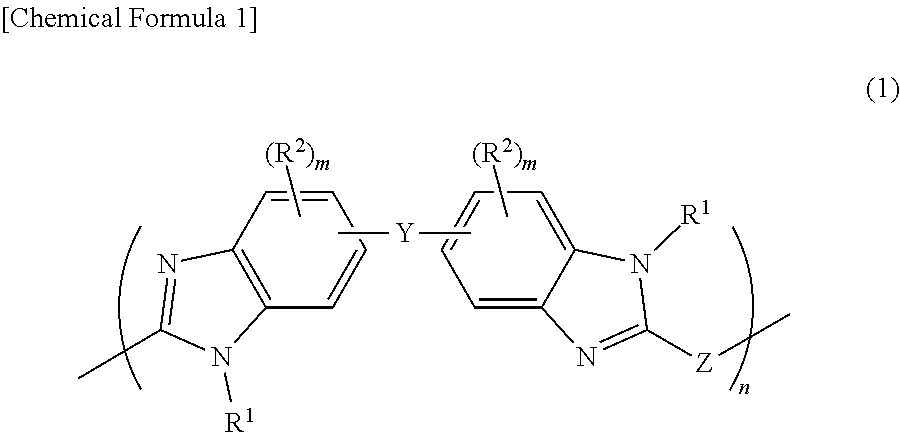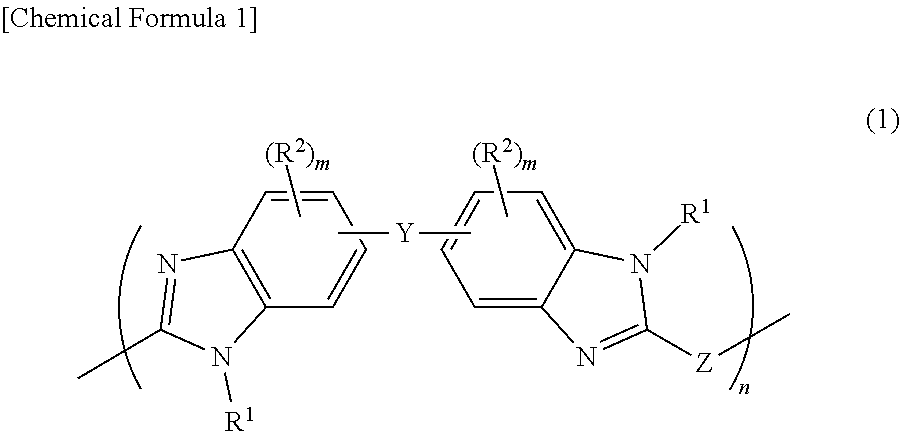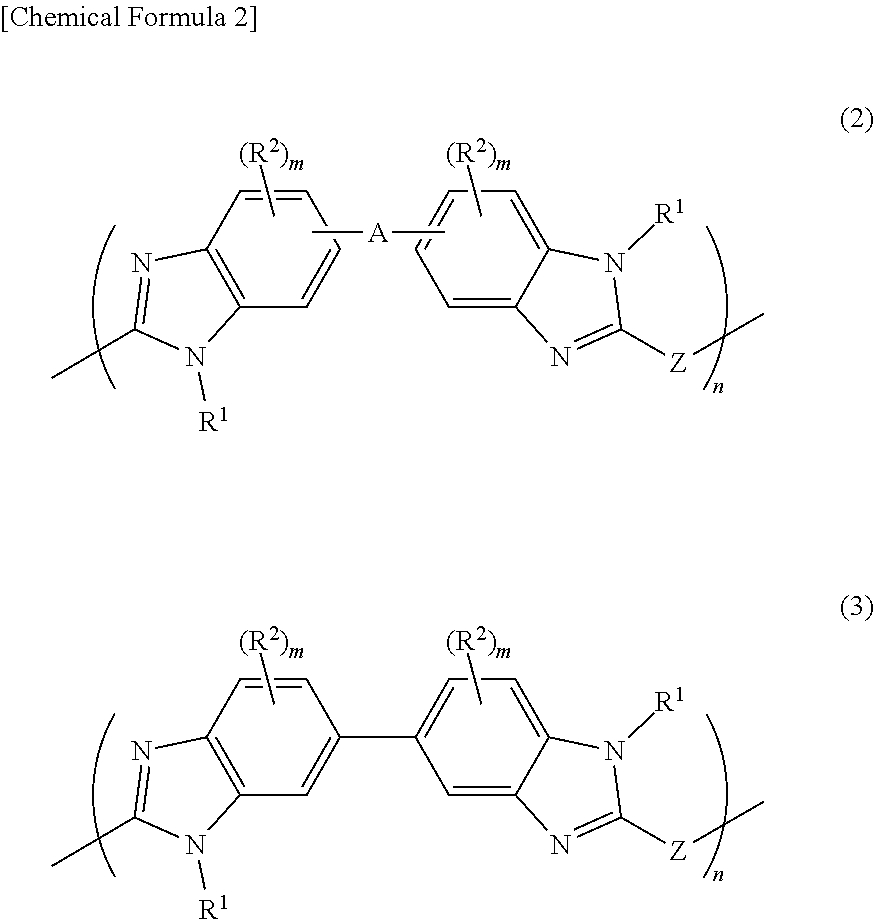Film forming material for lithography, composition for film formation for lithography, underlayer film for lithography, method for forming pattern, and purification method
a technology of lithography and lithography film, applied in the field of lithography film forming material, composition for lithography, underlayer film for lithography, method for forming pattern, and purification method, can solve the problems of resist patterns that cannot be obtained in sufficient thickness for substrate processing, and are demanded to be thinned, so as to achieve excellent heat resistance and etching resistance
- Summary
- Abstract
- Description
- Claims
- Application Information
AI Technical Summary
Benefits of technology
Problems solved by technology
Method used
Image
Examples
synthesis example 1
[0204]3,3′,4,4′-Tetraaminobiphenyl (manufactured by Kanto Chemical Co., Inc.; 3.14 g, 10 mmol) was added to polyphosphoric acid (50 g) in a 200-mL eggplant flask, and stirred in an oil bath at 160° C. for 3 hours to dissolve the tetraaminobiphenyl in the polyphosphoric acid. Isophthalic acid (manufactured by Mitsubishi Gas Chemical Company, Inc.; 1.46 g, 10 mmol) was added to a uniform solution, and the resultant was stirred for 24 hours after the temperature of the oil bath was raised to 200° C. Next, the reaction mixture was cooled to 80° C. (when possible, cooled to room temperature), and 100 mL of distilled water was carefully added thereto. The mixed liquid was stirred at room temperature for 1 hour and thereafter suction filtered, the residue was washed with distilled water (20 mL×5), thereafter 200 mL of an aqueous saturated sodium hydrogen carbonate solution was added thereto, and the resultant was stirred at room temperature for 6 hours. Furthermore, the residue was washed ...
synthesis example 1-1
[0205]Dry DMF (50 mL) was added to polybenzimidazole PBI-n (771 mg, 2.5 mmol) obtained in Synthesis Example 1, in a 100-mL eggplant flask, and thus a uniform solution was prepared. Cesium carbonate (2.44 g, 7.5 mmol) was added to the solution and stirred at room temperature for 30 minutes, and thereafter benzyl bromide (1.03 g, 6 mmol) was dropped thereinto over 10 minutes. The reaction mixture was stirred at room temperature for 12 hours and thereafter dropped into 200 mL of methanol to thereby obtain a fibrous precipitate. The precipitate was washed with methanol (50 mL×10) with suction filtration, and the residue was dried in vacuum at 60° C. for 24 hours to thereby obtain benzyl-protected polybenzimidazole represented by the following formula, as a beige solid at a yield of 97% (1.18 g). A resin obtained had a molecular weight Mn of 18690 and a polydispersity Mw / Mn of 2.8.
synthesis example 1-2
[0206]Dry DMF (50 mL) was added to polybenzimidazole PBI-n (771 mg, 2.5 mmol) obtained in Synthesis Example 1, in a 100-mL eggplant flask, and thus a uniform solution was prepared. Cesium carbonate (2.44 g, 7.5 mmol) was added to the solution and stirred at room temperature, and thereafter ethanol bromide (0.32 g, 6 mmol) was dropped thereinto. The reaction mixture was stirred at room temperature for 6 hours and thereafter dropped into 200 mL of methanol to thereby obtain a fibrous precipitate. The precipitate was washed with methanol (50 mL×10) with suction filtration, and the residue was dried in vacuum at 60° C. for 24 hours to thereby obtain hydroxyethyl-protected poly benzimidazole represented by the following formula, at a yield of 95% (1.18 g). A resin obtained had a molecular weight Mn of 13200 and a polydispersity Mw / Mn of 2.9.
PUM
| Property | Measurement | Unit |
|---|---|---|
| Temperature | aaaaa | aaaaa |
| Composition | aaaaa | aaaaa |
| Ratio | aaaaa | aaaaa |
Abstract
Description
Claims
Application Information
 Login to View More
Login to View More - R&D
- Intellectual Property
- Life Sciences
- Materials
- Tech Scout
- Unparalleled Data Quality
- Higher Quality Content
- 60% Fewer Hallucinations
Browse by: Latest US Patents, China's latest patents, Technical Efficacy Thesaurus, Application Domain, Technology Topic, Popular Technical Reports.
© 2025 PatSnap. All rights reserved.Legal|Privacy policy|Modern Slavery Act Transparency Statement|Sitemap|About US| Contact US: help@patsnap.com



